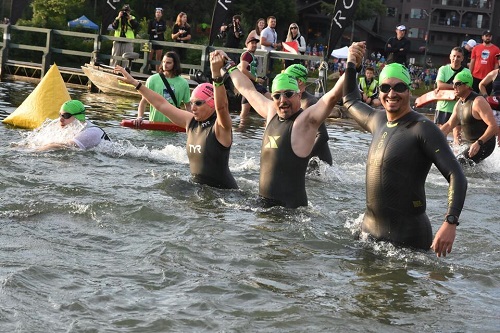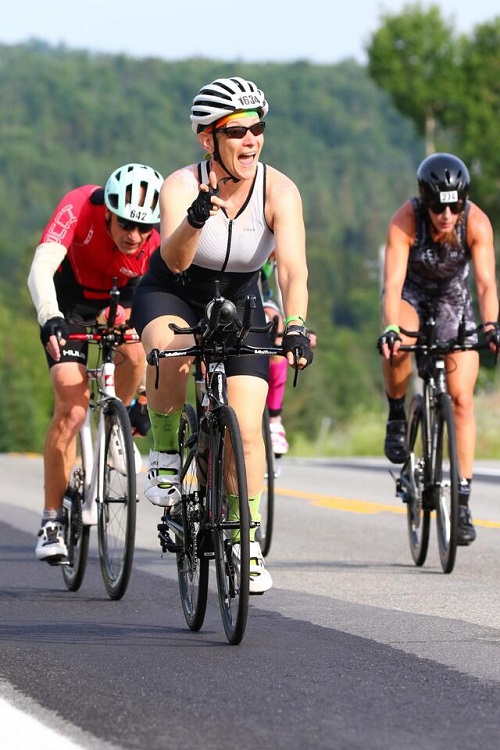Thank you for being part of my journey to become an Ironman. I hope you’ve enjoyed the other posts to date that highlighted the 2.4-mile swim, the 112-mile bike, the 26.2-mile run, and the numerous supporters who helped me along the way. Now it’s time to answer your questions:

What Made You Start Doing Ironman Races?
Coach David is certified in train people to do running races and triathlons. After I completed my first marathon, I said I wanted to cross train with swimming and biking. That led to me signing up for a sprint triathlon in 2018 to see if I liked doing all three activities consecutively.
About 10 seconds into that race, I thought, “Yeah, I like this.” Once I finished that race, I signed up for and competed in my first Half Ironman in Maine in 2019. That was also the first race I did with my coach. I went into that race with the plan that if I liked the Half Ironman that the next step would be to do the full.
What is the Cut Off Time for Each Segment?
Swim: 2 hours, 20 minutes after the last swimmer enters the water
Bike: 5:30 p.m.
Run: 17 hours or midnight
Did You Have a Time Goal for Each Segment or was the Goal to Finish with Little Regard for Time Other Than to Make the Cut Offs?
My goal was to finish within 17 hours. I didn’t have any goals for each segment.
What was Your Strategy for Preparing for this Race that Wasn’t in the City Where You Live?
Most of my swim training was in the pool and not in a lake, but that’s probably true for most racers. Two days before the race, my coach took me for a practice swim in the lake where we’d be racing so I could get comfortable with the water and the guide cable.
The Lake Placid bike course is notorious for its hills. Earlier in my training, I did my long rides at South Mountain where the inclines were as steep as Lake Placid, but not as long. As it got hotter, I had to do my bike rides closer to home because I couldn’t logistically make it work to get up, drive to the mountain, and do my workout before it got too hot.
I had the same issue with running. For my long runs, I had to do loops where I regularly stopped at home to refill my Gatorade and drink extra water because it was so hot. I regularly ran hills because the Lake Placid run course was also quite hilly, but the shorter hills closer to home were more than sufficient.
We knew my longest training days would be hotter but less humid than Lake Placid. Part of why I arrived days before the race was to adapt to the time change and get used to the humidity.

Did You Get Kicked a lot in the Swim?
Did I get kicked? Yes – kicked, hit, and bumped. I also ran into a kayak and more than one buoy.
I wouldn’t say I got kicked a lot. Taking the inside track had the advantage of keeping me away from a lot of the other swimmers. I wanted to be on the left side of the guide cable, and most people opted for the right side.
Did You Use Multiple Strokes and Which One was the Dominant One?
I used freestyle (front crawl) for the entire swim. That’s what I trained with. I saw and passed one swimmer who appeared to be doing the breast stroke the whole way.
Unlike most races, Lake Placid had a guide cable, so I didn’t have to spot the buoys during the swim. It’s also why I ran into at least two of them. In a race without a guide cable, I could see myself doing mostly freestyle with the occasional breast stroke break to better track the buoys while maintaining forward momentum.
As a Non-Binary Person, How was Your Experience in the Transition Area?
The transition area had two changing tents – one for men and one for women. As I entered the transition area during T1 (swim to bike) and T2 (bike to run), there was a different volunteer directing the racers to the tents, saying “Women here. Men down there.”
Each time, I responded with “I’m non-binary,” and without skipping a beat, the volunteer said, “Use whichever one you want.”
I doubt the volunteers had training about what to do with non-binary racers because Ironman does not currently offer a non-binary division. Instead, I think their supportive responses were likely due to the volunteers thinking one or both of the following:
- I don’t care.
- It’s your race. Do whatever you need to do.

What Socks Did You Wear for Ironman?
For the bike, I wore DeFeet 6” cycling socks. For the run, Feetures Elite Max Cushion socks.
How Were Your Interactions with Other Competitors?
Super friendly! If you’re racing near me, you’re not there to win. You’re there for the experience and to finish. There was lots of upbeat encouragement between us.
What Did You do for Nutrition?
In the final days before the race, I ate as much as I could. In the morning before the race, I had overnight oats loaded with pumpkin seeds, almonds, chia seeds, ground flax seeds, peanut butter powder, protein powder, and raisins. I also had a banana.
Between the swim and the bike, I had a calorie-bomb cookie. During the bike ride, I had 2.5 scoops of chocolate protein powder in one of my water bottles. I grabbed a fresh Gatorade and half a banana at every aid station. I took a hit of BASE salt at every aid station. I had some gels during the ride too.
Between the bike and the run, I had some electrolyte gummy candies with caffeine. During the run, I had gels at Mile 5, 10, and 15. I drank Gatorade at most of the aid stations, and I took a hit of BASE salt at each mile marker.

How Did You Eat Enough?
You don’t. My coach lost 7 pounds during the race.
I couldn’t eat right after finishing the race, but once my body settled for a few hours, I was famished!
How Did You Handle the Heat?
Pretty well. Starting at Mile 47 of the bike, I dumped a bottle of cold water over my head at each aid station. During the run, I dumped ice into my sports bra at each aid station, and I ran through the “human car wash” each time a spectator set one up for us.
How Many Moments Did You Want to Quit During the Race?
None.

Did You have to Push Through any Walls You Hit, Both Physically and Mentally?
I never wanted to quit, but there were some challenging moments. The first was right before the race when we were squished together waiting to start the swim. I don’t do crowds well.
The second challenge was near the end of the first loop on the bike. I took a break at one of the aid stations, tired and frustrated, and I realized I was probably under fueled. Once I bumped up my calories and protein, I felt better. Shifting my mindset to accepting the pain made the second lap much easier.
At any Time During Training (as opposed to the race itself), Did You Consider Backing Out? If so, How did You Keep on Track?
No. Once I paid my registration fee, I was committed to race and the training it would take to get to the finish line. It was exceptionally challenging to do my long bike and run workouts in the Phoenix heat, but I pushed through.

What was Your Biggest Surprise During the Race?
I don’t think anything can fully prepare you to bike up the Lake Placid hills, particularly how long those climbs are. I trained on hills that were as steep as the Lake Placid hills, not nothing like how long those hills are. During my training, I regularly stood up on my pedals while climbing hills, and early on in the race I learned I go faster when I stay in the saddle.
Did Your Body Have any Serious Difficulties at any Point such as Cramps or Muscle Tightness that Made Progress Difficult?
No. By the time I got off the bike, my quads and hamstrings hurt a lot. I couldn’t lift my feet far off the ground. Every step hurt, but I was happy taking each of those steps.
At What Point on the Marathon Did You Know, “I’ve Got This?”
I knew from my first step into the run course. My legs were sore and tired, but I had plenty of time on clock to finish. It was just a matter of putting one foot in front of the other.

What was the Last Mile of the Marathon Like Physically and What was Going Through Your Mind?
By the last mile of the run, my legs were exhausted. I only ran when the course was flat or going downhill and walked every incline.
What was going through my mind? I was excited to cross the finish line and achieve this massive goal of becoming an Ironman. It was a bit overwhelming. I’d worked so hard for years, and this moment was finally here. As I crossed the finish line, I burst into tears, overwhelmed with joy and relief.
Being Non-Binary, Does the Gender Specific Name “Ironman” Bother You?
No. Ironman is a brand.
I’ve had people refer to me as an Iron Person, and I correct them saying, “I’m an Ironman.”

Are You Going to Get the Tattoo?
Of course! I plan to put a variation of the M-dot on the back of my calf.
Are You Going to do Another Ironman?
There’s a good chance. I’m looking at a Half Ironman for 2023 and a full Ironman in 2024.

What Would You do Differently?
If I do the Lake Placid Ironman or a race with a hilly bike course, I’ll change my winter and spring long bike workouts to include steeper and longer hill climbs.
One of the challenges I had with the long run workouts in the hot sun leading up to my race was exercise-induced vasculitis, aka Disney Rash. My legs between the bottom of my shorts and the top of my socks were covered with red splotches. After the race, I learned there are climate controlled indoor running tracks in my community. I will definitely use one of them for my long runs instead of running outside if I do another summer Ironman.

Do You Feel any Shifts in How You Think About or Carry Yourself After Completing such a Herculean Goal?
After the race, I started using the mantra, “Fuck you. I’m an Ironman.”
I only say this in my head, and I don’t use this in an I’m-Better-Than-You way. Instead, it’s an exultation to mean, “I can do this” when directed toward myself, and I’ve used it to mean “You can’t intimidate me” when directed towards opposing counsel.
Thank you for following along for my Ironman journey. I hope you enjoyed it!








